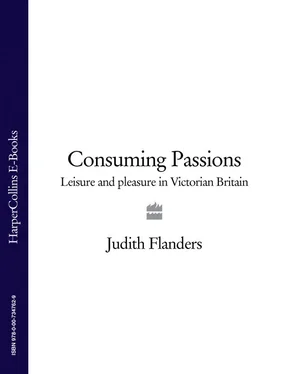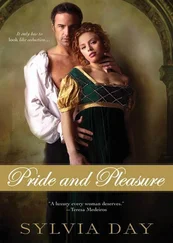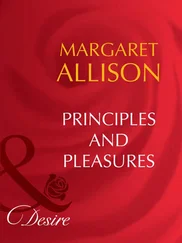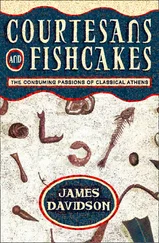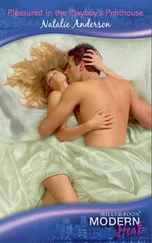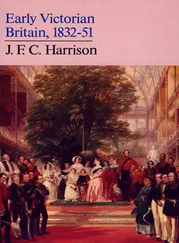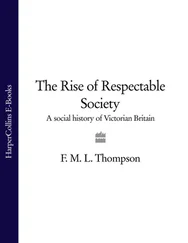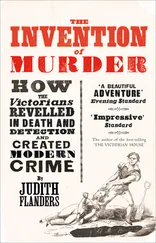These are a few small examples of the marked increase in the number of possessions among all classes, from Garrick and Colman’s countryhouse owners down to those who, in previous ages, would have inherited a few goods, possibly acquired a few more after much struggle, or simply done without. From 1785 to 1800—a mere fifteen years—the rate of consumption of what had previously been considered luxuries and were now regarded as part of the ordinary necessities of life increased at more than twice the rate of population growth. In those fifteen years the population of England and Wales rose by 14 per cent, while over the same period the demand for candles grew by 33.8 per cent, for tobacco by 58.9 per cent and for spirits by a staggering (literally, perhaps) 79.9 per cent, while demand for tea soared by 97.7 per cent and for printed fabrics by an astonishing 141.9 per cent. 41(For more on tea, see pp. 56—61.)
By the time of the Great Exhibition it was expected that one’s quality of life—one’s standard of living—could be judged by the number of possessions one owned, the number of things one consumed. This was an entirely new way of looking at things. The Oxford English Dictionary ’s first citation for the phrase ‘standard of living’ dates from 1879. Punch , as always quick to spot a novelty, was already making fun of the idea by 1880. In a George du Maurier cartoon, an ‘Æsthetic Bridegroom’ looks at an oriental teapot, saying to his ‘Intense Bride’, ‘It is quite consummate, is it not?’ She responds rapturously, ‘It is, indeed! Oh, Algernon, let us live up to it!’ 42Buying goods, owning goods—even living up to goods—were now virtues. Comfort was a moral good. A hundred years after Colman and Garrick wrote of the prosperous and their country houses, the Illustrated London News carried an advertisement for a piano, the purchase of which would make the ‘home more attractive and save [the family from] more expensive and dangerous amusements’. 43The advertisement could not be more explicit: buying commercially produced goods, in this case a piano, would make one’s family life more entertaining, safer and, somehow, better. This was not simply an advertising conceit. Ford Madox Brown, a founder of the Pre-Raphaelite movement, told one of his patrons that, to be happy, ‘much depends upon getting a house and adorning of a beautiful house’. 44In 1876 the Revd William Loftie, in A Plea for Art in the House , expanded on this idea: there ‘seems to be something almost paradoxical in talking about the cultivation of taste as a moral duty…[but] if we look on the home here as the prototype for the home hereafter, we may see reasons for making it a sacred thing, beautiful and pleasant, as, indeed, we have no hesitation about making our churches’. 45The cultivation of taste had become a ‘moral duty’, with the ‘sacred’ space, the shrine, epitomized by Paxton’s Crystal Palace, which looked like a great shining box built to hold all the commodities that could ever be produced. All the manufactured items in the world seemed to be collected under its transparent lid. It resembled nothing so much as one of those glass domes that Victorians put on their mantelpieces to protect their most precious objects from dirt and dust.
Looking back, it is possible to see, from the beginning, that the tendency to understand the Great Exhibition as a collection of so many items for sale was constantly being repressed. In 1850 the Westminster Review , in one of many press reports about the forthcoming event, warned, ‘The object of the Exhibition is the display of articles intended to be exhibited, and not the transaction of commercial business; and the Commissioners can therefore give no facilities for the sale of articles, or for the transaction of business connected therewith.’ Yet even the author of this stark caution found it hard to remember, immediately adding approvingly that the Exhibition was a ‘gathering together of the commercial travellers [salesmen] of the universal world, side by side with their employers and customers, and with a showroom for their goods that ought to be such as the world has never before beheld’. 46To attempt to block such commercial thoughts and concentrate visitors’ minds on the displays’ educational qualities, the organizers forbade the listing of prices, direct advertisements of goods, or any other form of overt selling. *
But, in a way no one could have foreseen, the lack of prices made everything appear much more available. No one looked at a display and thought, ‘That is out of my reach.’ Instead, everything became acquirable in the imagination, because nothing was for sale in reality. Everything could be dreamed of. At the same time, exhibitors, who had their own agendas, became ingenious in finding ways around the price ban as the fair continued. ‘Explanatory’ notes were handed out and, just coincidentally, were printed on the back of price lists; trade cards and advertising cards were distributed widely. Others outside the commissioners’ control abetted this urge to price the price-less: many press articles speculated on the value of goods when describing them—it seemed to be a reflex response to the display. As Walter Benjamin later commented, ‘The world exhibitions erected the universe of commodities.’ 47
For the first few weeks of the Great Exhibition, these price-less goods were examined by the prosperous alone. Albert had been insistent that the working class should be able to attend, that it was this group who would benefit in particular. The prices of admission, however, were set at exorbitant levels. Season tickets were £3 3 s . for men, £2 2 s . for women, and only season-ticket holders could go on the first day; second- and third-day tickets cost £1 each, while day tickets for the rest of the first month were 5 s . each. It was not until 26 May, nearly a full month after the opening, that for the first time ‘shilling days’ came into force, with the following Friday reduced even further, to 6 d . But on Saturdays—most workers’ half-day off—the price was pushed back up, to 2 s . 6 d . Many exhibitors wanted this exclusivity extended even further, with shilling days postponed until July—or never. They feared that the middle and upper classes who had thronged the aisles in the first weeks would disappear, not to be seen again, if they were forced to share their viewing space with the lower orders. But Prince Albert and Cole prevailed, and shilling days from the end of May remained.
As the end of the month approached, the big question of the day became, what would happen when the admission charge was lowered to let the working classes in? The gulf between the comfortable middle classes and even the respectable working classes was enormous. In the previous three-quarters of a century the middle class had become increasingly fearful of their social and economic inferiors, a situation brought about by the great political upheavals of the time. The Gordon Riots of 1780, the fall of the Bastille in 1789, the Peterloo Massacre of 1819, the agitations that surrounded the Reform Act of 1832, and the Chartist riots; the failed harvests of the ‘hungry forties’; and, only three years in the past, the Europe-wide revolutions of 1848: all had merged to form a nebulous image of the great mass of workers biding their time, waiting to turn into ‘King Mob’. This was how The Times referred to the working class on 2 May, the day after the opening of the Great Exhibition—the day referred to by Queen Victoria as ‘the greatest day in our history, the most beautiful and imposing and touching spectacle ever seen, and the triumph of my beloved Albert’. 48 The Times was not so confident. Surely these bogeymen would overrun the grounds, given half a chance? Mayhew despaired of those like The Times who were stoking fear: ‘For many days before the “shilling people” were admitted to the building, the great topic of conversation was the probable behaviour of the people. Would they come sober? will they destroy things? will they want to cut their initials, or scratch their names on the panes of the glass lighthouses?’ 49 Punch , in ‘Open House at the Crystal Palace’, also (unusually) championed the workers at the expense of the middle classes, setting up ‘Young Mob’ as ‘the better-behaved son of a wild and ignorant father’: ‘Am I not seen with my wife and children wondering at MR. LAYARD’s Nineveh Marbles [in the British Museum] *- wondering quietly, and I will add, if you please, reverently? Have I, in fact, chipped the nose of any statue? Have I wrenched the little finger from any mummy? Have I pocketed a single medal?’ 50Even those who did not fear that riot and mayhem would arrive with the workers thought that financial ruin certainly would. The Illustrated London News warned that ‘the gay, glancing, fluttering tide of bonnets and ribbons, and silks, and satins, and velvets’, would vanish, with ‘the blank…filled up by no adequate substitute of meaner, or coarser, or more commonplace material’. 51These publications were more interested in their thesis than in giving the shilling days a chance: this particular piece was published after only the third shilling day.
Читать дальше
